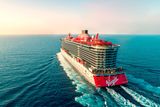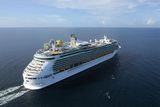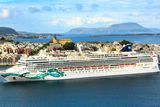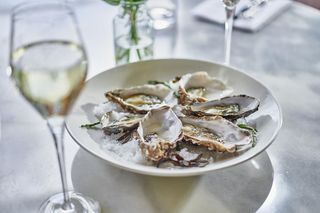‘An open mind and an empty stomach’ – six things every first-time cruise passenger should know



Not all cruise holidays are the same.
In fact, there are an increasingly diverse array of sailings for nearly every type of traveller - luxury cruise expeditions, family-friendly voyages and even mass-market cruise lines that are more adult-oriented and, well, just a bit cheeky.
Earlier this summer, I went into my first cruise as an adult with an open mind - and an empty stomach.
As a writer who focuses on land-and-air-based exploration, I'll admit that a cruise is out of my typical travel comfort zone. Beyond the floating-hotel-at-sea concept that makes novice cruisers a bit apprehensive, a cruise required me to give someone else full control of an itinerary. In other words, much of my type-A travel planning and intense oversight of a trip had to go out of the window - or in this case, out the ship's porthole.
A cruise's schedule is laid out before you - day by day, hour by hour. You know which port of call you will arrive and depart from at a given time, and there's even a daily printout of the happenings and events onboard.
However, it's not all just handed to you on a silver platter either; there are still quite a bit of adjustments to get that first cruise just right.
Here are six lessons from my first time cruising, from costs to planning.
1. Manage expectations for what you can see on land
For this trip, I went on a week-long sailing in the Mediterranean on the 1,400-cabin Valiant Lady, one of three medium-sized vessels that are currently sailing under Richard Branson's Virgin Voyages line.
While this specific itinerary meant many stops along the rugged French and Spanish coastline, it also prompted a very rookie mistake - trying to do too much in one port of call.
Don't try to cram in everything while on land. Not only will it be rushed, but you won't be able to get a proper feel for a destination. On most sailings, you're only docked for a set period during the day (or at most, one night).
I learned this the hard way on one of our first port days, trying to squeeze in sightseeing the city of Nice, the medieval village of Eze and the nation of Monaco, all in one day. (Yes, in hindsight, it's a clear what-are-you-thinking moment.)
For cruises where you're in a place for less than 24 hours, the whole point is really to get a preview of a destination; not to fully immerse. Here's what I'd recommend instead: Pick one activity - say sea kayaking along the French Riviera - or explore one specific neighbourhood (in my case, one city) to give yourself plenty of time to make it back to the ship.
Then, next time, come back and see the rest.
Read more
The author's balcony. Photo by Chris Dong
2. Research the vibe of your cruise line and ship
Cruise lines - and even specific ships - take all forms of shapes and sizes, with each having a specific vibe. Don't be fooled by a one-size-fits-all cruiser stereotype.
There are the boomer cruise lines. The family cruise lines. The gay cruises. The nudist cruises. You get the idea.
Virgin Voyages made a splash for being adults-only since its inaugural sailing in 2021. Travellers under the age of 18 years old aren't allowed onboard. The Virgin branding is also a bit irreverent and caters to a diverse and eclectic crowd. It's a little suggestive, a little risqué, and sometimes a lot of both. A significant portion of guests identify as LGBTQ+.
Each cruise line is known for different things though, so prepare accordingly.
3. What you pay upfront isn't necessarily the full price of your cruise
While cruises are often assumed to be a mostly inclusive experience, there are a bunch of additional expenses that can cause sticker shock at the end of a journey.
First of all, cruises typically operate cashless, so it's a simple tap of your key card or wristband to complete transactions onboard (that's tied to a credit card on file). It's frictionless, and perhaps maybe too easy.
Then, consider some of the basic expenses like alcoholic and nonalcoholic drinks (cappuccinos, fresh-pressed juices and the like are usually not included). Of course, spa treatments, the casino, and perhaps even a tattoo (yes, that's offered onboard Virgin Voyages) can quickly add up and inflate the original price tag. Don't forget gratuities, which on some cruise lines can be upward of €20 per person per day.
Finally, if you plan to spend time on land (and you should), there are necessary costs to consider. While you can often pre-book land activities before you set sail, you have to decide whether to do that on your own or through the ship's shore excursion desk. The former may be more cost-effective but the latter is more convenient - and guarantees that the ship won't leave without you.
One of the author's meals on board. Photo: Chris Dong
4. Expect some lines, even if your cruise isn't full
If you're on a medium- to large-sized vessel, there's just no getting around this one. While some of the more premium cruise lines will dedicate more space per person, the physics of a space-constrained vessel with a few thousand passengers (and crew) means that you should expect lines for a variety of day-to-day activities.
My particular sailing was only at half capacity, yet there were significant lines for getting on and off the ship (perhaps the biggest bottleneck for larger vessels) as well as the shuttle buses to and from the port. While it may be minor, you have to take into account queues for anything and everything, from getting into the evening's show to waiting for your turn at the photo booth.
Don't get me wrong: There are plenty of nooks and crannies to acquire some Zen, but there's just no way for a larger vessel to truly feel serene at all times.
5. Arrive at your embarkation city early
Try to arrive at your embarkation point as early as possible, ideally the day before. Flight delays and travel mishaps can submerge your entire itinerary before even setting sail.
And during a peak travel period like the summer, there isn't a lot of slack in the system - one flight delay could mean the difference between making your cruise and missing it completely.
If you can, arrive at the port city a few days before and see the city. In my case, Barcelona was the starting point for my week-long cruise journey. I used that opportunity to nibble on Spanish tapas, stroll along Passeig de Gràcia and gawk at Gaudi's iconic creations.
6. Try everything on the ship at least once
If you're going on a bigger ship, odds are there are a number of dining venues, bars and entertainment spaces. Get a barometer for each experience and then go back to the things that you really enjoyed.
On Virgin Voyages, I sampled each of the main dining venues on consecutive nights. Then, I decided which to return to by Day 6 for an encore.















.jpg)
